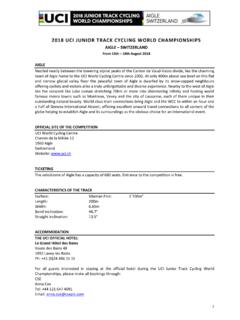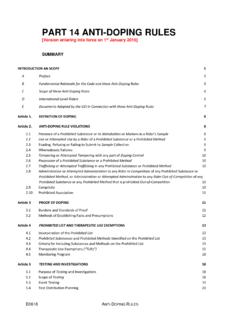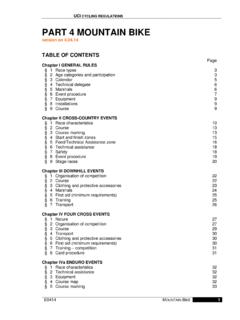Transcription of UCI Wheel approval procedure 1. Introduction
1 UCI Wheel approval procedure 1. Introduction The UCI has reviewed the application process for the approval of wheels (Article of the Cycling Regulations) and with effect from the 1st of January 2016 the following process will need to be complied with. New wheels launched after this date will need to comply with this process. The wheels approved under the previous procedure do not need to be retested, and are still allowed. The wheels produced before the 1st January 2016 and not yet approved must be tested under the new approval procedure . The significant difference in this reviewed testing procedure is that it is no longer required to use an appointed testing laboratory. The tests can now be carried out by manufacturers using their own testing facilities and with them then certifying that the tests complied with that detailed below. This self certification is in common with ISO standards and as such is standard across industry.
2 Wheel manufacturers without testing facilities should contact the UCI equipment unit for guidance on available facilities that can be used to conduct tests. 2. approval procedure 1. A request for approval of the wheels must be made to the UCI by the manufacturer and must meet all conditions. 2. The application for approval must contain the following documents : - Letter from the manufacturer Confirmation of successful test confirming the testing procedure complied with - The document Wheels approval application form . - A complete report of the test containing : - Name of laboratory where the test has been made - 2 pictures (from 2 different views) of the test installation - 2 pictures (from 2 different views) of the Wheel in place on the test installation - The values of the lateral and radial run out after the test - A video of the test in which the reference of the Wheel can easily be identified (to send by email to Copy of the documents available at regulations/equipment-165067/.)
3 3. On receipt of the application, the UCI will issue an invoice to the manufacturer for the cost of the procedure , which is 250,- CHF per Wheel . union cycliste internationale 23 d cembre 2016 1. 4. If the application is accepted, and after reception of the payment, the UCI will grant approval by certificate to the manufacturer within 2 months of the date the complete application and payment are received. 5. When a new Wheel is approved, the official list of approved wheels will be updated with the name of the new Wheel . This list can be found at and-regulations/equipment-165067/. 6. The UCI will inform the national federations, commissaires and all other parties that it considers to be concerned via the usual channels. 7. approval shall lapse automatically should the type or the family of Wheel undergo technical changes and/or developments.
4 In such instances the manufacturer must inform the UCI. and re-apply for approval . 8. approval may be withdrawn or suspended by the Equipment Commission at any time in any of the following cases: - of new information reported or coming to light, or experience with the use of the equipment, which justifies the withdrawal or suspension of approval - evidence comes to light which may reasonably give rise to the belief that examples put on the market do not conform with the approved type. 9. The UCI has the right but not the obligation to check the quality or the characteristics of wheels put onto the market. The UCI shall have no liability in this respect, the manufacturer alone being responsible for the quality and compliance of wheels put onto the market. 10. Commissaires, the members of the Equipment Commission and any other official shall forbid the use of any Wheel which seems to them not to conform to an approved type of Wheel .
5 Neither these persons, nor the UCI nor any other cycling body shall incur any liability if a non-compliant Wheel is not identified as such. 11. approval shall not constitute certification or endorsement by the UCI of the characteristics of the Wheel . It shall constitute only authorization for use. union cycliste internationale 23 December 2016 2. 3. Wheel impact test - Test to be complied with Test method: Vertical drop test (neutralization of the rebound of the anvil). Wheel : Wheel tested without tire. Energy level: 40 Joules Impact striker geometry: Flat steel anvil, the impact surface is covered with a silicone rubber pad of 20mm thickness (Hardness Shore A=50 +/- 5, Compression set of 40% acc. To ASTM D395 Methode B). The rubber pad requires to be undamaged. Picture 1: Vertical drop test installation Picture 2: Flat steel anvil with covered surface Impact mass: Range of 6 - 10kg Energy must always remain at 40 Joules at the hit with a +/- 5% tolerance.
6 Hitting point: One hit at 90 from valve hole, adjusted to have the point between the spokes Failure criteria (for alloy and carbon wheels): No visible cracks or delamination No change in lateral profile or in lateral run out in excess of No change in radial profile or in radial run out in excess of union cycliste internationale 23 December 2016 3. 4. Wheel information Wheels to be tested: The wheels used in massed start competition in the disciplines Road and Cyclo-Cross must be tested. Only the front wheels are concerned, as it was done in the previous test at Sirris laboratory. The wheels which meet the definition of traditional wheels do not need to be certified. Definition of Traditional wheels: Criteria: Rim height: Less than 25mm Rim material: Alloy Spokes: Minimum of 20 steel spokes which are detachable General: All components must be identifiable and commercially available Submissions from manufacturers must be addressed by mail to the UCI, at the address : union cycliste internationale Equipment Coordinator Chemin de la M l e 12.
7 1860 Aigle SWITZERLAND. union cycliste internationale 23 December 2016 4.







